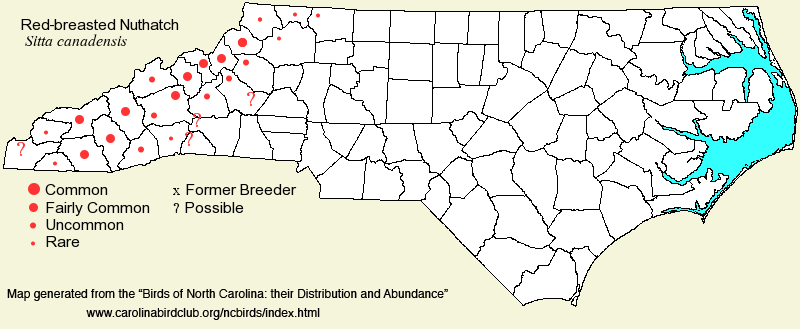 |  |
|
Red-breasted Nuthatch - Sitta canadensis SITTIDAE Members: | Search Common: Search Scientific: |
|
|
|||||||
| General Comments | The Red-breasted Nuthatch is the only one of the four nuthatches in North America that is strongly migratory; the others migrate little if at all. Unlike most migratory species, which conduct regular and predictable migrations in spring and fall, this species behaves like several "winter finches" -- it moves far to the south, covering all of North Carolina, in some autumns and winters, and essentially stays close to its breeding range in others. Thankfully, it nests southward into the higher mountains of North Carolina; thus, birders are guaranteed of seeing it every year, at least in summer. The breeding population is rather stable from summer to summer, but downstate, the birds can be rare to locally absent in some winters, to fairly common or occasionally common in others. It is nearly always seen in conifers, preferably spruce or fir, and formerly hemlocks (mostly dead or dying now), but they can even be seen in Longleaf Pine stands. Favored breeding habitats are spruce-fir stands, but they also occur in remnant hemlock or White Pine stands, usually where the micro-climate is cool. In recent years, for some odd reason (as summers have been getting warmer), a few birds appear to be moving into dry pine habitats in the foothills and are presumably nesting. Downstate, favored habitats are conifer or mixed conifer-hardwood stands, even in Virginia Pine stands. They almost always "troop" around in mixed-species flocks in the winter season, and often come to bird feeders. | ||||||
| Breeding Status | Breeder | ||||||
| NC BRC List | Definitive | ||||||
| State Status | W | ||||||
| U.S. Status | |||||||
| State Rank | S3B,S4N | ||||||
| Global Rank | G5 | ||||||
| Coastal Plain | Fall transient and winter visitor (little northbound movement noted); very erratic from year to year. In better seasons, can be fairly common to occasionally common in fall along the coast, and fairly common in winter. In off-years near the coast, uncommon at best in fall, and often rare in fall and in winter. Farther inland, uncommon to at times fairly common in winter in the better years, but usually rare (at best) in others. Inland, most numerous in the Sandhills, but cyclical there, also. Mainly early or mid-Sep to mid-Apr, but often scarce by late winter. Peak counts: 138, Kitty Hawk CBC, 19 Dec 2020; 76, Kitty Hawk CBC, 15 Dec 2012; 50+, Carvers Creek SP (Cumberland), 20 Oct 2012; 50+, Bodie Island lighthouse entrance road, 2 Nov 2012. | ||||||
| Piedmont | Fall transient and winter visitor (little northbound movement noted); very erratic from year to year. In better seasons, fairly common to occasionally common; however, more often than not, rare to uncommon across the province; locally absent in a few winters. Apparently nested (accidentally) in Rockingham in 1975; a juvenile was being fed by adults on 7 Jun. Five birds at three locales in South Mountains SP (Burke) in early Jun 2008 also might have suggested potential (accidental) nesting; one to several have continued there for at least three additional years. Perhaps a slight decline in recent decades; seldom common since about 1980. Mainly mid-Sep to mid-Apr. Quite unusual was one that lingered through the entire summer in Durham in 2014, as was another all summer (at least to 28 Jul) at a feeder in Chatham in 2024. Peak counts: | ||||||
| Mountains | Summer resident and winter visitor; very erratic outside the breeding season. In summer, fairly common at high elevations (over 4,500 feet); uncommon down to about 3,000 feet in a few cool micro-climate areas. In the past few years, small numbers have appeared down to about 1,500 feet, even in dry stands of pines, such as Virginia Pines and Shortleaf Pines. At other seasons, at least below the breeding range, fairly common in some winters, and rare to uncommon in others. It also winters within the breeding range; thus, found at most elevations at that season. Breeding status has held steady or slightly declined in recent decades. Peak counts: 63, Roan Mountain, 11 Nov 1993. | ||||||
| Finding Tips |
The birds are too erratic in fall, winter, and spring to offer tips; thus, look for them in summer. A trip to Mount Mitchell SP, the Roan Mountain area, and the Blue Ridge Parkway between Devils Courthouse and the Heintooga Road area are consistently good. *** | ||||||
| Attribution | LeGrand[2024-11-06], LeGrand[2024-08-06], LeGrand[2023-03-27] | ||||||
| NC Map Map depicts all counties with a report (transient or resident) for the species. | Click on county for list of all known species. |
| NC Breeding Season Map Map depicts assumed breeding season abundance for the species. |  |